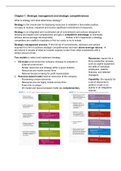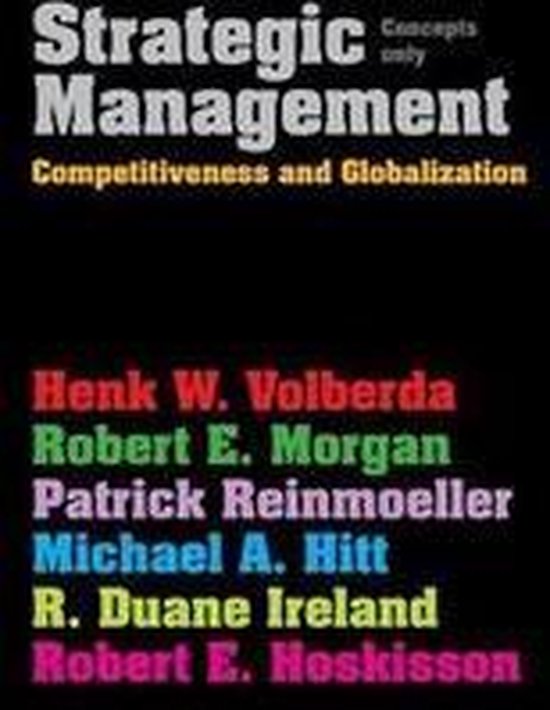Chapter 1: Strategic management and strategic competitiveness
What is strategy and what determines strategy?
Strategy is the overall plan for deploying resources to establish a favourable position.
not easy to reverse, important and involve significant commitment of resources.
Strategy is an integrated and coordinated set of commitments and actions designed to
develop and exploit core competencies and gain a competitive advantage, to eventually
achieve above-average returns(profits). when a firm implements a strategy,
competitors are unable to duplicate or find too costly to try to imitate
Strategic management process the full set of commitments, decisions and actions
required for a firm to achieve strategic competitiveness and earn above-average returns.
are returns in excess of what an investor expects to earn from other investments with a
similar amount of risk.
Two models to select and implement strategy: Resources: inputs into a
1. I/O model environment the company chooses to compete in firm’s production process,
- External environment such as capital equipment,
- Similar resources and strategy within a given industry the skills of individual
employees, patents,
- Resources are mobile across firms
finances, and talented
- Rational decision-making for profit maximization
managers.
2. Resource-based model internal resources of the company
- Possessing unique resources Capability: the capacity for
- Resources are not highly mobile across firms a set of resources to
- Every firm is unique perform a task or an
I/O model and resource-based model are complementary activity in an integrative
manner.
,Stakeholder: are those who can affect, and are affected by, a firm’s strategic outcomes. A
firm is dependent on support of stakeholders, they have claims on the company’s
performance.
Three groups:
1. Capital market: shareholders and major suppliers of capital (banks)
2. Product market: primary customers, suppliers, host communities, and unions
3. Organizational: employees, managers and nonmanagers
The current competitive landscape:
In need of a different mindset, one that allows them to compete in highly turbulent and
chaotic environments.
The cause is the globalisation of industries and rapid technological changes.
Vision: a picture of what the firm want to be and what it wants to achieve.
Mission: the business(es) the firm intends to compete in and costumers it intends to serve.
Vision and Mission: provide direction to the firm and signal important information for
stakeholders.
Strategic leaders: people located in different parts of the firm using the strategic
management process to help the firm reach its vision and mission. They predict the
outcomes of their strategic decisions, to this they first calculate profit pools in their industry
that are linked to the value chain activities.
Profit pool entails the total profits earned in an industry at all points along the value chain.
Chapter 2: The external environment
There are three levels:
1. General environment:
Composed of dimensions in the broader society that
influence an industry and the firms in it.
- Firms cannot directly control the seven segments.
1. Demographic: population size, age structure, income
distribution
2. Economic: inflation/interest rates, savings rates
3. Political/legal: taxation/antitrust laws, educational philosophies, and policies
4. Sociocultural: women in the workforce, attitude about the quality of work life
5. Technological: product innovations, applications of knowledge
6. Global: critical global markets, important political events
7. Physical environment: advocacy groups, waste reduction
2. Industry environment:
Is a set of factors that directly influences a firm and its competitive actions and
competitive responses. (Porter’s Five Forces)
3. Competitor analysis
How companies gather and interpret information about their competitors
- What drives the competitor? future objectives
- What is the competitor doing and what can he do? Current strategy
- What believes the competitor about the industry? Assumptions
- What are the capabilities of the competitor? Strength and weaknesses
,
, External environment analysis:
1. Scanning: identifying early signals of environmental changes and trends.
2. Monitoring: observing environmental changes to see if an important trend is
emerging form among those spotted through scanning.
3. Forecasting: developing projections of what might happened, and how quickly, as a
result of the changes and trends detected through scanning and monitoring.
4. Assessing: determining the timing and significance of the effects of environmental
changes and trends that have been identified.
Porter’s Five Forces that drive industry competition and profitability
How profitable a specific industry is in the long term?
1. Threat of new entrants
When the threat is high prices low profitability is most likely low
Presence of entry barriers:
- Economies of scale: newcomers must make a big investment to enter, because the
other firms have efficiency improvements through experience.
- Product differentiation: makes it difficult for newcomers to steal the costumers,
costumers believe the product of the firm is unique.
- Switching costs: the one-time costs costumer incurs when the buy from a different
supplier.
- Capital requirements: require resources to invest.
- Access to distribution channels: companies have relationships with the external
distributers.
- Cost disadvantages independent of scale: often newcomers cannot duplicate the
cost advantages some firms have.
- Government policy: through licensing and permit requirements the governments can
control entry into an industry.
Expected retaliation
How do I expect the other firms to react when I enter the industry?
- How has the firm responded on previous new entrants?
- Does the firm possess substantial resources?
2. Bargaining power of suppliers:
Strong when:
Suppliers are more concentrated that the industry they sell to
Few suppliers lot of buyers
Substitutes are not available
High prices cannot look for a substitute
Do not depend heavily on the industry for its revenue
Have more industries they sell to
Face switching costs in changing suppliers
Suppliers offer products that are differentiated
Suppliers can credibly threaten to integrate forward
3. Bargaining power of buyers
Strong when:





